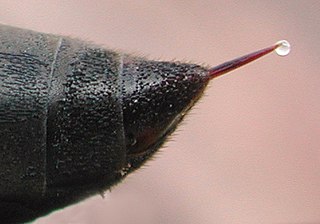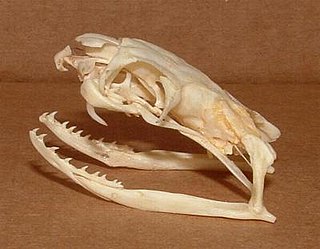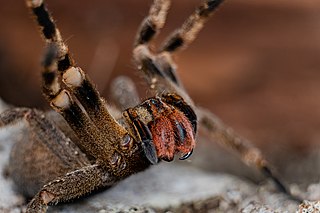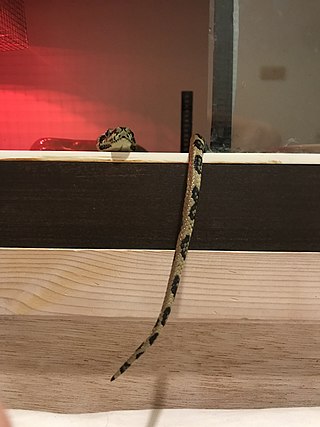Related Research Articles

Venom or zootoxin is a type of toxin produced by an animal that is actively delivered through a wound by means of a bite, sting, or similar action. The toxin is delivered through a specially evolved venom apparatus, such as fangs or a stinger, in a process called envenomation. Venom is often distinguished from poison, which is a toxin that is passively delivered by being ingested, inhaled, or absorbed through the skin, and toxungen, which is actively transferred to the external surface of another animal via a physical delivery mechanism.

Phoneutria is a genus of spiders in the family Ctenidae. They are mainly found in northern South America, with one species in Central America. Members of the genus are commonly referred to as Brazilian wandering spiders. Other English names include armed spiders and banana spiders.

Antivenom, also known as antivenin, venom antiserum, and antivenom immunoglobulin, is a specific treatment for envenomation. It is composed of antibodies and used to treat certain venomous bites and stings. Antivenoms are recommended only if there is significant toxicity or a high risk of toxicity. The specific antivenom needed depends on the species involved. It is given by injection.

A conotoxin is one of a group of neurotoxic peptides isolated from the venom of the marine cone snail, genus Conus.

Toxicofera is a proposed clade of scaled reptiles (squamates) that includes the Serpentes (snakes), Anguimorpha and Iguania. Toxicofera contains about 4,600 species of extant Squamata. It encompasses all venomous reptile species, as well as numerous related non-venomous species. There is little morphological evidence to support this grouping; however, it has been recovered by all molecular analyses as of 2012.

The Chinese red-headed centipede, also known as the Chinese red head, is a centipede from East Asia. It averages 20 cm (8 in) in length and lives in damp environments.

Venomous snakes are species of the suborder Serpentes that are capable of producing venom, which they use for killing prey, for defense, and to assist with digestion of their prey. The venom is typically delivered by injection using hollow or grooved fangs, although some venomous snakes lack well-developed fangs. Common venomous snakes include the families Elapidae, Viperidae, Atractaspididae, and some of the Colubridae. The toxicity of venom is mainly indicated by murine LD50, while multiple factors are considered to judge the potential danger to humans. Other important factors for risk assessment include the likelihood that a snake will bite, the quantity of venom delivered with the bite, the efficiency of the delivery mechanism, and the location of a bite on the body of the victim. Snake venom may have both neurotoxic and hemotoxic properties. There are about 600 venomous snake species in the world.

A spider bite, also known as arachnidism, is an injury resulting from the bite of a spider. The effects of most bites are not serious. Most bites result in mild symptoms around the area of the bite. Rarely they may produce a necrotic skin wound or severe pain.

Phoneutria nigriventer is a species of medically-significant spider in the family Ctenidae, found in the Southern Cone of South America. Along with other members of the genus, they are often referred to as Brazilian wandering spiders.

Venomous fish are species of fish which produce strong mixtures of toxins harmful to humans which they deliberately deliver by means of a bite, sting, or stab, resulting in an envenomation. As a contrast, poisonous fish also produce a strong toxin, but they do not bite, sting, or stab to deliver the toxin, instead being poisonous to eat because the human digestive system does not destroy the toxin they contain in their bodies. Venomous fish do not necessarily cause poisoning if they are eaten, as the digestive system often destroys the venom.

Ancylometes is a genus of Central and South American semiaquatic wandering spiders first described by Philipp Bertkau in 1880. Originally placed with the nursery web spiders, it was moved to the Ctenidae in 1967. The genus name is derived in part from Ancient Greek "ἀγκύλος", meaning "crooked, bent".

Caudal luring is a form of aggressive mimicry characterized by the waving or wriggling of the predator's tail to attract prey. This movement attracts small animals who mistake the tail for a small worm or other small animal. When the animal approaches to prey on the worm-like tail, the predator will strike. This behavior has been recorded in snakes, sharks, and eels.

Cupiennius salei, from the genus Cupiennius also commonly called the Tiger bromeliad spider, which are large bodied, actively-hunting spiders that are part of the family Trechaleidae.
CSTX is a name given to a group of closely related neurotoxic peptides present in the venom of the wandering spider Cupiennius salei. There are twenty types so far described for this protein group. However, some are reclassified into cupiennins group of toxin, including CSTX-3, -4, -5, and -6, because of their chemical affinity. The first thirteen were isolated and identified in 1994 by Lucia Kuhn-Nentwig, Johann Schaller, and Wolfgang Nentwig of the Zoological Institute at the University of Bern, Switzerland. The different types are most likely the products of splicing variant of the same gene. They are all L-type calcium channel blockers, and also exhibit cytolytic activity by forming an alpha-helix across the cell membrane in mammalian neurons. They also inhibit voltage-gated calcium channels in insect neurons.
Cupiennins are a group of small cytolytic peptides from the venom of the wandering spider Cupiennius salei. They are known to have high bactericidal, insecticidal and haemolytic activities. They are chemically cationic α-helical peptides. They were isolated and identified in 2002 as a family of peptides called cupiennin 1. The sequence was determined by a process called Edman degradation, and the family consists of cupiennin 1a, cupiennin 1b, cupiennin 1c, and cupiennin 1d. The amino acid sequences of cupiennin 1b, c, and d were obtained by a combination of sequence analysis and mass spectrometric measurements of comparative tryptic peptide mapping. Even though they are not strong toxins, they do enhance the effect of the spider venom by synergistically enhancing other components of the venom, such CSTX.

Venom in snakes and some lizards is a form of saliva that has been modified into venom over its evolutionary history. In snakes, venom has evolved to kill or subdue prey, as well as to perform other diet-related functions. While snakes occasionally use their venom in self defense, this is not believed to have had a strong effect on venom evolution. The evolution of venom is thought to be responsible for the enormous expansion of snakes across the globe.
The pathophysiology of a spider bite is due to the effect of its venom. A spider envenomation occurs whenever a spider injects venom into the skin. Not all spider bites inject venom – a dry bite, and the amount of venom injected can vary based on the type of spider and the circumstances of the encounter. The mechanical injury from a spider bite is not a serious concern for humans. Some spider bites do leave a large enough wound that infection may be a concern. However, it is generally the toxicity of spider venom that poses the most risk to human beings; several spiders are known to have venom that can cause injury to humans in the amounts that a spider will typically inject when biting.
Venomics is the study of proteins associated with venom, a toxic substance secreted by animals, which is typically injected either offensively or defensively into prey or aggressors, respectively.
U7-ctenitoxin-Pn1a (or U7-CNTX-Pn1a for short) is a neurotoxin that blocks TRPV1 channels, and can exhibit analgestic effects. It is naturally found in the venom of Phoneutria nigriventer.

Delta hexatoxin Hv1 is a neurotoxic component found in the venom of the Australian funnel web spider.
References
- 1 2 Wigger E, Kuhn-Nentwig L, Nentwig W (2002). "The venom optimisation hypothesis: a spider injects large venom quantities only into difficult prey types". Toxicon. 40 (6): 749–752. Bibcode:2002Txcn...40..749W. doi:10.1016/S0041-0101(01)00277-X. PMID 12175611.
- 1 2 Morgenstern D, King GF (2013). "The venom optimization hypothesis revisited". Toxicon. 63: 120–128. Bibcode:2013Txcn...63..120M. doi:10.1016/j.toxicon.2012.11.022. PMID 23266311.
- ↑ Nisani Z (2008). Behavioral and Physiological Ecology of Scorpion Venom Expenditure: Stinging, Spraying, and Venom Regeneration. pp. 32–39. ISBN 9780549591610.
- ↑ Kuhn-Nentwig L, Fedorova IM, Lüscher BP, Kopp LS, Trachsel C, Schaller J, Vu XL, Seebeck T, Streitberger K, Nentwig W, Sigel E, Magazanik LG (2012). "A venom-derived neurotoxin, CsTx-1, from the spider Cupiennius salei exhibits cytolytic activities". J Biol Chem. 287 (30): 25640–25649. doi: 10.1074/jbc.M112.339051 . PMC 3408166 . PMID 22613721.
- ↑ Nentwig W (1986). "Non-webbuilding spiders: prey specialists or generalists?". Oecologia. 69 (4): 571–576. Bibcode:1986Oecol..69..571N. doi:10.1007/BF00410365. PMID 28311618. S2CID 5871434.
- ↑ Boevé JL, Kuhn-Nentwig L, Keller S, Nentwig W (1995). "Quantity and quality of venom released by a spider (Cupiennius salei, Ctenidae)". Toxicon. 33 (10): 1347–1357. Bibcode:1995Txcn...33.1347B. doi:10.1016/0041-0101(95)00066-U. PMID 8599185.
- ↑ Kuhn-Nentwig L, Schaller J, Nentwig W (2004). "Biochemistry, toxicology and ecology of the venom of the spider Cupiennius salei (Ctenidae)". Toxicon. 43 (5): 543–553. Bibcode:2004Txcn...43..543K. doi:10.1016/j.toxicon.2004.02.009. PMID 15066412.